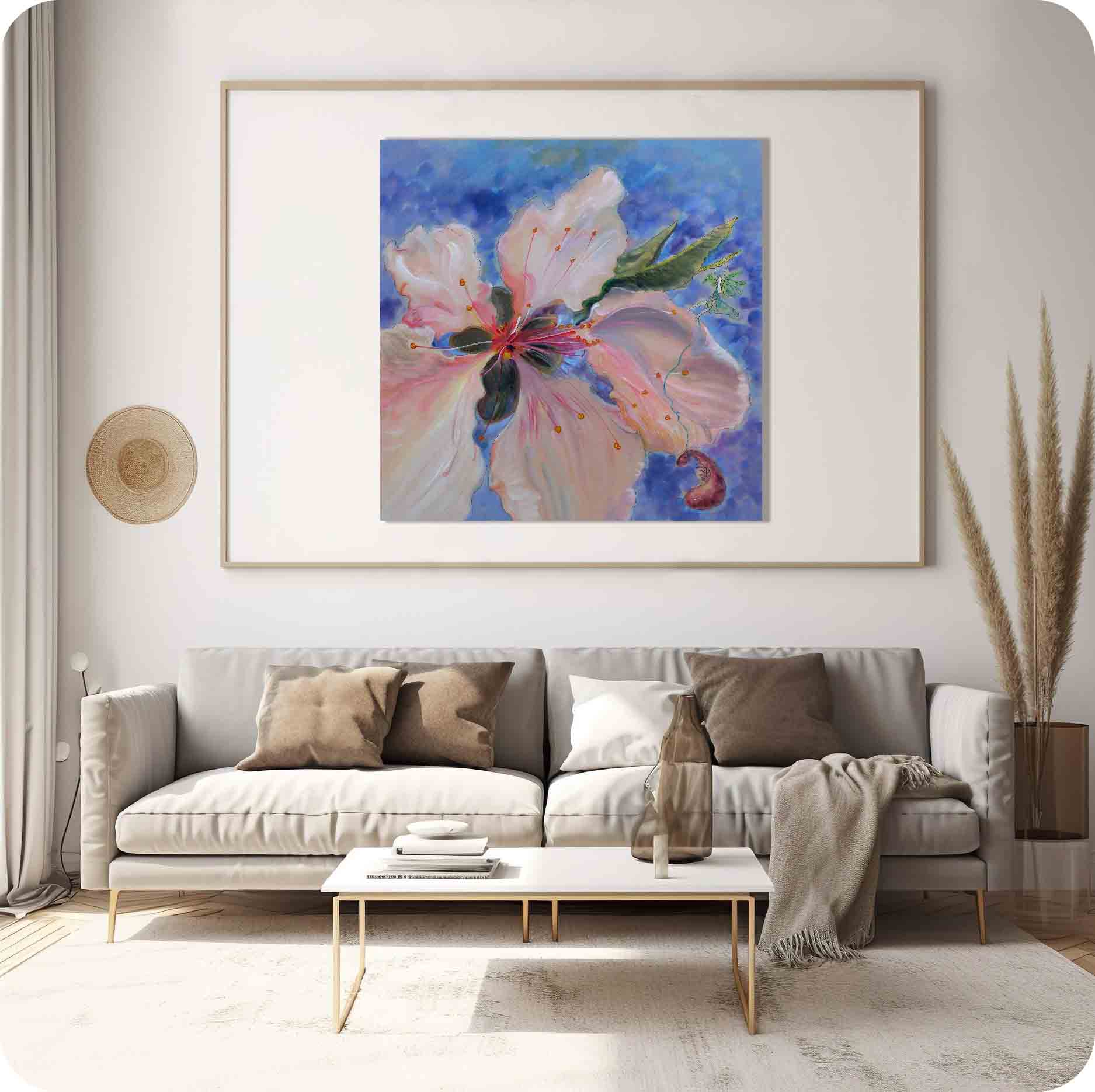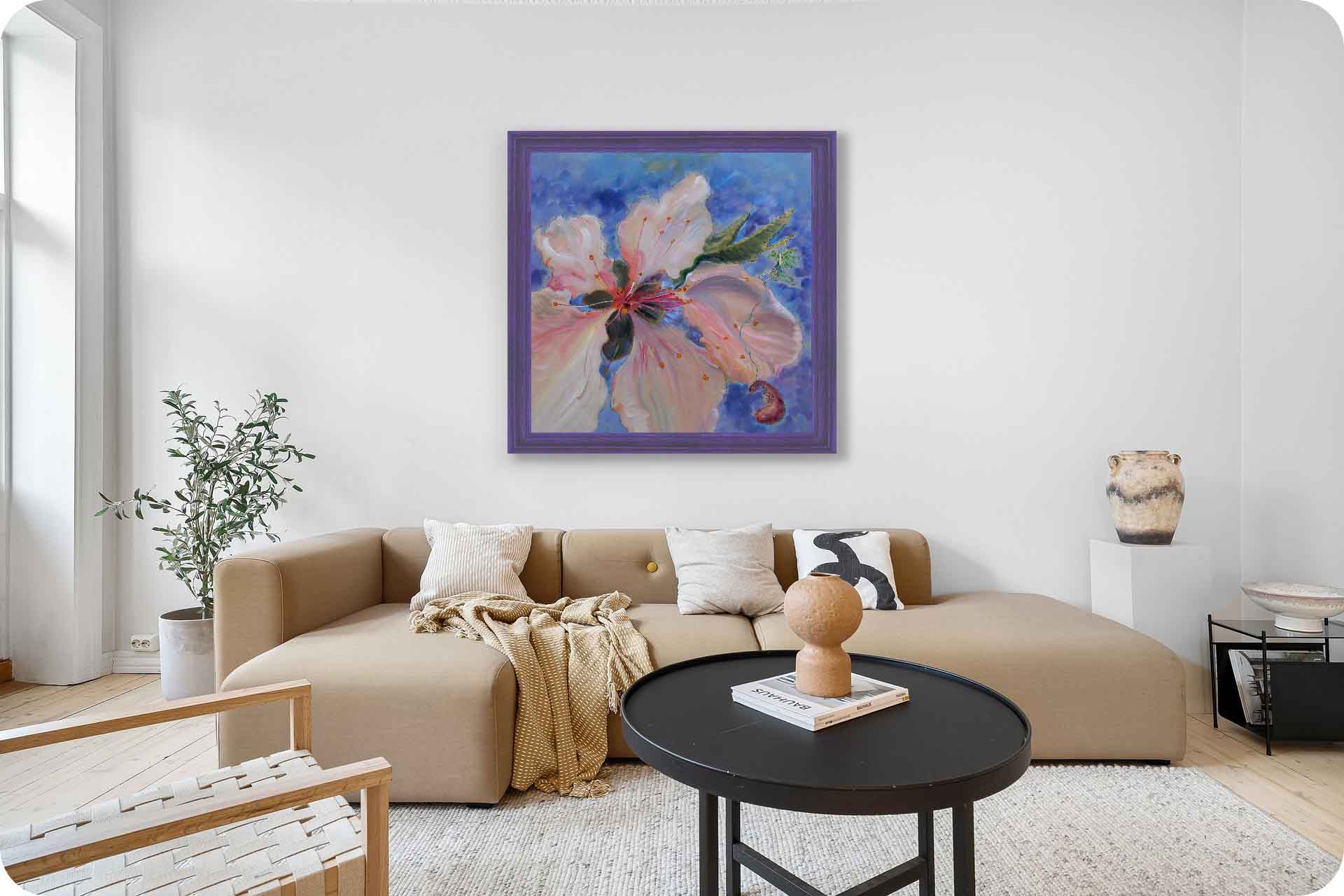The theme of this year's painting clearly states one - the makeup of desire. People's various desires are wrapped under various makeups. Desires are the intertwining of happiness and pain in life. Either straightforward or subtle, they will appear in makeup, forming a profound look of an era.
If spring is compared to a person, then beauty is the desire of spring, desire is the action of "loneliness", and flowers are the makeup of "desire".
Inches: 23.6 x 23.6 in
Size without the frame: 60 x 60 cm
Country: China
Date: 2024
Materials: Acrylic paint on linen
Condition: well preserved
Creative themes and style | My works revolve around the creative concept of "The land of humanity, People on the land".The people in the painting are people in nature, and the lines, shapes, and colors are close to nature. The nature in the painting is nature in the eyes of humans, existing in interaction with humans.I don’t pursue a series of works with a fixed and continuous style. I hope that the style of the pictures will synchronize with the changes in my life and always remain oscillating. The performance of the work must be in sync with the development of one's own life in order to be Sincere and powerful.Ideas are later.
An Interview with Artist Philo by Artphiloso Gallery
If you would like to collect this artwork or know more about the artist, please contact us.


1. Subject and Composition
At the center of the painting lies a blooming flower, its large pink-white petals expanding outward in a luminous gesture. Executed with a wet-blending technique, the petals shift in soft gradients, evoking the gentle radiance of early spring light. This painterly treatment conveys both the warmth of life and the fragile transience of seasonal change.
The stamens, highlighted by interwoven tones of gold and red, form a visual and emotional climax. This concentrated use of color suggests vitality and passion, anchoring the composition with energy that counters the flower’s delicate transparency.
2. Surreal Elements and Symbolism
Alongside the petals, a tiny fairy-like figure is sketched with delicate line drawing, clinging lightly to a leaf. This whimsical presence introduces a surreal element, dissolving the boundary between natural realism and dream. As a spiritual companion, the fairy transforms the bloom into more than a botanical subject—it becomes a stage for emotional resonance. In this way, the work implies that even amidst flourishing spring, the soul may still seek companionship and connection.
3. Color Dynamics and Atmosphere
The background, composed of blended blue and purple tones, sets a cool and atmospheric contrast to the warm hues of the petals. This chromatic interplay produces a sense of tension, embodying the paradox of “loneliness within liveliness.” The title, Symptoms of Loneliness in Spring, is thus not a literal description but a visual metaphor, reflecting an individual’s dialogue with oneself and the world in the midst of seasonal beauty.
4. Emotional Projection and Style
The painting resonates with the aesthetics of Neo-Romanticism, where natural imagery becomes an emotional mirror. By fragmenting the theme of loneliness into collisions of color, form, and line, the artist probes the coexistence of solitude and companionship.
Every gradient across a petal, every wandering curve of the fairy’s outline, echoes this search for harmony between inner solitude and outer abundance. The work invites viewers to look beyond surface beauty, engaging with the emotional depth that art reveals when solitude is reimagined as poetic expression.
Chen Jialing’s Flowers
Through ink-wash rendering and exaggerated shapes, Chen creates poetic, fantastical visions of flowers. Similarly, Symptoms of Loneliness in Spring employs heightened form and atmosphere to evoke a dreamlike quality.
Wu Guanzhong’s Spring Like Threads
Using flexible lines and light colors, Wu conveys lyrical delicacy. Both works emphasize the poetic essence of spring through minimal yet evocative brushwork.
Georgia O’Keeffe’s Giant Flowers
By adopting close-up perspectives and soft tonal transitions, O’Keeffe amplifies floral intimacy. Likewise, this painting magnifies the flower into an emotional landscape, revealing the hidden delicacy of the micro-world.
Marc Chagall’s Bouquet and Lovers
Chagall’s integration of dreamlike figures with flowers parallels the use of the fairy here. Both works merge reality and surreal fantasy, creating a romantic, poetic visual experience.
Symptoms of Loneliness in Spring transforms a flower into a Neo-Romantic metaphor for solitude and vitality. Through the interplay of warm and cool colors, surreal symbolism, and poetic transformation, the painting speaks to the universal tension between inner solitude and outer abundance, turning seasonal beauty into a meditation on the soul’s quiet yearning.
This painting uses a blue-purple background with varying shades, resembling shimmering waves that create a flowing sense of space. The petals are primarily soft pink and white, with delicate hints of blush and violet shading, giving them a rhythm as if they were breathing. The harmony between the background and the flowers makes the composition both tranquil and full of tension.
The petals are painted in an open and expansive manner, with softly curling edges that seem to dance with the wind. The stamens extend outward in fine red and orange-yellow lines, ending in glowing dots that scatter like starlight, giving the flower a powerful sense of expansion and energy.
Amid the large flower forms, subtle details emerge: on one side, a shape resembling a seed pod, and on the other, tiny figures that look like dancing spirits. These details break away from the purely floral theme, infusing the artwork with a touch of surrealism and suggesting the hidden rhythms of life within nature.
Because this artwork combines elegance with a sense of fantasy, it is ideal for atmospheric home décor, especially in living rooms or creative studios. It instantly enhances the uniqueness of a space and appeals to younger buyers who seek personalized art for home decoration.
This piece blends the natural beauty of flowers with symbolic, imaginative elements, giving it both modern abstract art collectible value and aesthetic appeal. In today’s art market, it functions not only as a striking hand-painted floral artwork for investment but also as a piece with long-term potential for appreciation, making it highly suitable for inclusion in a personal art collection.
A: Click here to view ARTPHILOSO's Guide for Collectors.
More paintings from this series:
Symptoms of loneliness in spring 1 Symptoms of loneliness in spring 2
Symptoms of loneliness in spring 3
Symptoms of loneliness in spring 5 Symptoms of loneliness in spring 6
Symptoms of loneliness in spring 7 Symptoms of loneliness in spring 9
